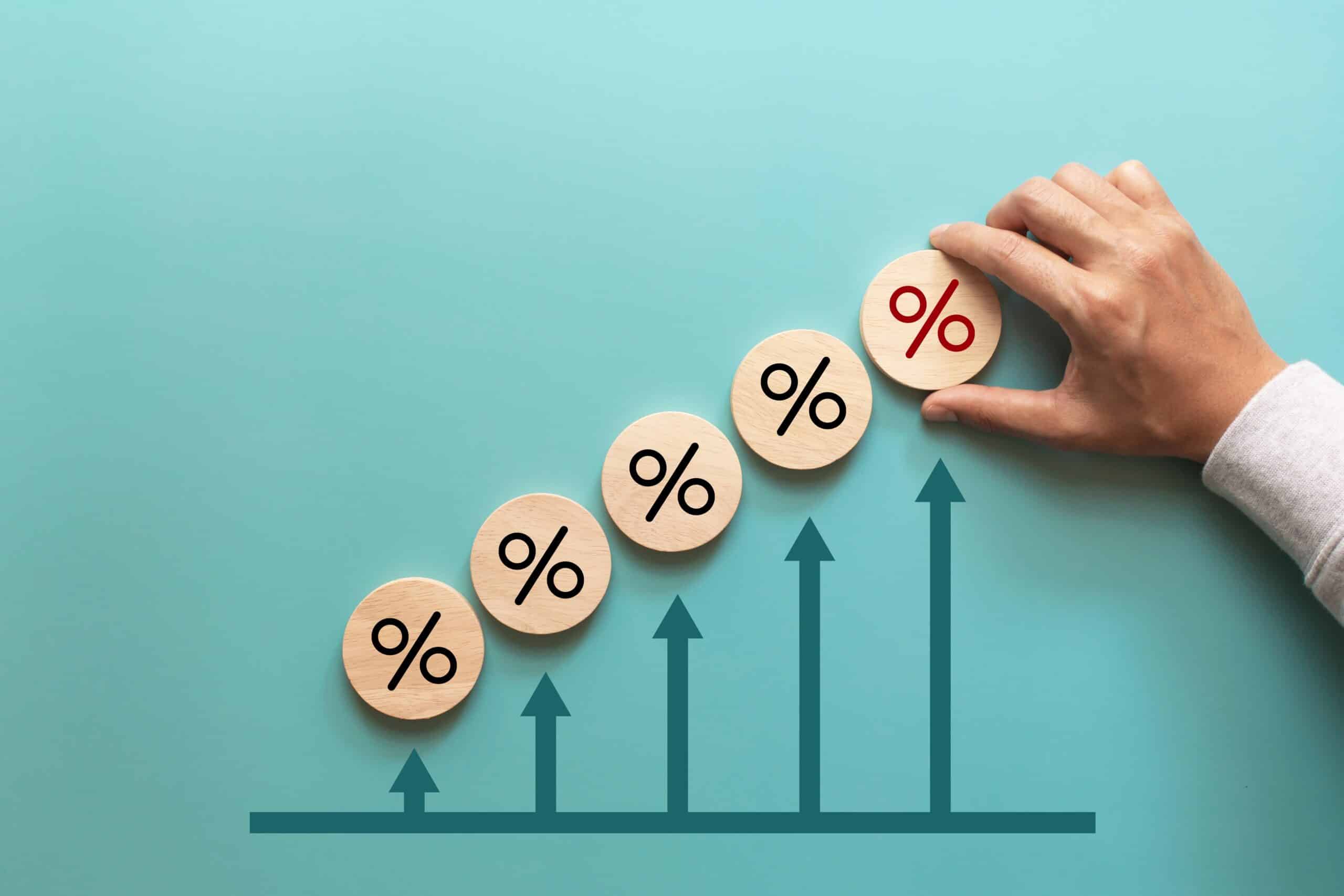Table of contents
Commercial loan interest rates are critical for businesses seeking financing for growth, operations, or expansion. These rates determine the cost of borrowing and can significantly impact a company's financial health. Understanding how commercial loan interest rates are calculated is essential for making informed borrowing decisions.
By comprehending the factors that influence these rates, business owners, financial officers, and entrepreneurs can better evaluate their loan options and select the most cost-effective financing solutions.
What Are Commercial Loan Interest Rates?
Commercial loan interest rates are the cost of borrowing for businesses, expressed as a percentage of the loan amount. These rates represent the price paid by borrowers to lenders for the use of their money over a specified period. Interest rates are crucial because they directly affect the overall cost of the loan, influencing the total amount that must be repaid. For businesses, securing loans with favorable interest rates is essential for managing expenses, maintaining cash flow, and achieving financial goals without overburdening their budgets.
Interest rates are typically annualized, meaning they are expressed as an annual percentage rate (APR). This rate includes not only the interest cost but also any additional fees or charges associated with the loan, providing a more comprehensive view of the borrowing costs.
Types of Commercial Loan Interest Rates
- Fixed Interest Rates: Fixed interest rates remain constant throughout the loan term, regardless of market fluctuations. This stability makes it easier for businesses to plan their finances, as they know exactly how much they will pay in interest each month. Fixed rates provide predictability and protection against rising market interest rates. They are ideal for businesses that prefer certainty in their financial planning and want to avoid the risk of increasing interest costs.
- Variable Interest Rates: Variable interest rates fluctuate based on changes in an underlying benchmark rate, such as the prime rate or the London Interbank Offered Rate (LIBOR). These rates can increase or decrease during the loan term. Variable rates can be beneficial when market interest rates are expected to decline, potentially reducing the overall cost of borrowing. However, they also carry the risk of rising rates, which can lead to higher interest expenses and financial unpredictability.
- Adjusted Interest Rates: Adjusted interest rates are typically tied to a base rate with an added margin or spread determined by the lender. The base rate can be a benchmark rate like the prime rate, and the spread is based on the borrower’s creditworthiness and loan terms. These rates provide a balance between fixed and variable rates. They offer some stability with the potential for adjustments based on market conditions and the borrower’s financial performance.
Understanding these different types of commercial loan interest rates helps businesses choose the best financing option that aligns with their risk tolerance, financial stability, and market expectations. By evaluating the pros and cons of each type, businesses can make informed decisions that support their long-term financial health and growth objectives.
Factors Influencing Commercial Loan Interest Rates
Understanding the various factors that influence commercial loan interest rates can help businesses better prepare for the borrowing process and negotiate favorable terms.
Here are the key factors that lenders consider when setting interest rates:
Creditworthiness of the Borrower
- Credit Score: Both personal and business credit scores play a significant role in determining the interest rate. Higher credit scores indicate lower risk to the lender, often resulting in lower interest rates. Conversely, lower credit scores can lead to higher rates due to perceived higher risk.
- Credit History: A strong credit history with timely repayments and low outstanding debt indicates financial responsibility and reliability. Lenders review the borrower’s credit history to assess their risk profile.
- Debt-to-Income Ratio: This ratio compares the borrower’s monthly debt payments to their gross monthly income. A lower ratio suggests better financial health and a higher capacity to repay the loan, potentially leading to lower interest rates.
Loan Amount and Term Length
- Loan Amount: Larger loan amounts may come with lower interest rates due to economies of scale and the lender's desire to secure large, lucrative deals. However, very large amounts might require more stringent approval processes.
- Term Length: The length of the loan term can affect the interest rate. Short-term loans often have higher rates due to quicker repayment periods and less interest accumulation, while long-term loans might offer lower rates but accumulate more interest over time.
Economic Conditions
- Market Interest Rates: Prevailing market interest rates, influenced by the central bank’s monetary policy, play a crucial role. For instance, when the Federal Reserve lowers interest rates, commercial loan rates typically decrease, and vice versa.
- Inflation: Higher inflation rates can lead to higher interest rates as lenders seek to maintain their profit margins and offset the declining purchasing power of money
- Economic Stability: During periods of economic uncertainty or recession, lenders may increase interest rates to mitigate higher default risks. Conversely, in stable economic conditions, rates may be more favorable.
Lender Policies and Market Competition
- Lender’s Risk Appetite: Different lenders have varying levels of risk tolerance. Some may offer competitive rates to attract more borrowers, while others might set higher rates to mitigate risk.
- Market Competition: In highly competitive markets, lenders might lower interest rates to attract more business. Businesses should shop around and compare offers from multiple lenders to secure the best rate.
- Relationship with Lender: Long-standing relationships with a lender can lead to more favorable terms and lower interest rates. Demonstrating loyalty and financial reliability can be advantageous during negotiations.
Collateral Provided
- Secured vs. Unsecured Loans: Secured loans, which require collateral, generally come with lower interest rates because they pose less risk to the lender. Collateral can include real estate, equipment, inventory, or other valuable assets.
- Quality and Value of Collateral: The type and value of the collateral also influence the interest rate. High-value collateral that is easy to liquidate can result in lower rates. Conversely, low-value or difficult-to-sell collateral might not significantly reduce rates.
- Loan-to-Value (LTV) Ratio: This ratio compares the loan amount to the appraised value of the collateral. A lower LTV ratio indicates more equity in the collateral, reducing the lender’s risk and potentially leading to lower interest rates.
Several factors influence the interest rates on commercial loans, from the borrower's creditworthiness and loan specifics to broader economic conditions and lender policies. By understanding these factors, businesses can better prepare for the loan application process, negotiate more favorable terms, and make informed financial decisions. It's essential for business owners to maintain strong credit profiles, provide valuable collateral, and stay informed about economic trends to secure the best possible interest rates for their commercial loans.
How Are Commercial Loan Interest Rates Calculated?
Understanding how commercial loan interest rates are calculated can help businesses make informed decisions and better negotiate loan terms. Here’s a step-by-step breakdown of the calculation process, along with example scenarios and an explanation of fixed vs. variable interest rates.
The step-by-step process for calculating commercial loan interest rates is:
- Determine the Base Rate: The base rate is the starting point for calculating the interest rate. It is usually influenced by benchmark rates such as the prime rate, LIBOR (London Interbank Offered Rate), or the federal funds rate. Lenders add a margin to this base rate to determine the final interest rate.
- Add the Margin: The margin is an additional percentage added to the base rate. It reflects the lender’s assessment of the borrower’s credit risk, loan amount, and term length. The margin can vary significantly based on these factors.
- Consider the Loan Term: The term length of the loan can affect the interest rate. Typically, longer-term loans might have higher interest rates to compensate for the extended risk period, while shorter-term loans might have lower rates but higher monthly payments.
- Adjust for Creditworthiness: The borrower’s creditworthiness plays a crucial role. Lenders assess the borrower’s credit score, financial history, and debt-to-income ratio to adjust the interest rate accordingly. A higher credit score can lead to a lower interest rate, while a lower score can increase the rate.
- Include Any Additional Fees: Lenders might include various fees in the interest rate calculation, such as origination fees, application fees, and administrative costs. These fees are often expressed as points (one point equals 1% of the loan amount).
Some interest rate scenarios depending on loan term are:
Scenario 1: High Creditworthiness, Short-Term Loan
- Base Rate: 3% (Prime Rate)
- Margin: 1% (Low-risk borrower)
- Total Interest Rate: 4%
For a loan amount of $500,000 with a 2-year term:
- Monthly payment (approx.): $21,735
- Total interest paid over the term: $20,827
Scenario 2: Average Creditworthiness, Long-Term Loan
- Base Rate: 3% (Prime Rate)
- Margin: 3% (Moderate-risk borrower)
- Total Interest Rate: 6%
For a loan amount of $500,000 with a 10-year term:
- Monthly payment (approx.): $5,551
- Total interest paid over the term: $166,136
Scenario 3: Low Creditworthiness, Long-Term Loan with Additional Fees:
- Base Rate: 3% (Prime Rate)
- Margin: 5% (High-risk borrower)
- Additional Fees: 1% (Expressed as points)
- Total Interest Rate: 9%
For a loan amount of $500,000 with a 10-year term:
- Monthly payment (approx.): $6,337
- Total interest paid over the term: $260,439
Fixed vs. Variable Interest Rates
Fixed Interest Rates: Fixed interest rates remain constant throughout the loan term, regardless of market fluctuations. The rate is set at the beginning of the loan and does not change.
- Advantages: Predictability and stability. Fixed rates make it easier for businesses to budget and plan their finances, as the monthly payments remain the same.
- Disadvantages: Potentially higher initial rates compared to variable rates. If market rates drop, borrowers with fixed rates do not benefit from the decrease.
Variable Interest Rates: Variable interest rates fluctuate based on changes in an underlying benchmark rate, such as the prime rate or LIBOR. The rate can increase or decrease during the loan term.
- Advantages: Initially lower rates compared to fixed rates. If market rates decrease, borrowers benefit from lower interest payments.
- Disadvantages: Uncertainty and potential for increased costs. Variable rates can rise, leading to higher monthly payments and overall interest costs.
Practical Example of Fixed vs. Variable Rates
Consider a $500,000 loan with a 5-year term:
Fixed Rate:
- Interest Rate: 5%
- Monthly Payment: $9,434
- Total Interest Paid: $66,035
Variable Rate:
- Initial Rate: 4% (assume the rate can vary between 4% to 7% over the term)
- Monthly Payment (initial): $9,207
- Total Interest Paid (assuming rate increases to an average of 6%): $81,327
In the variable rate scenario, if the interest rate increases, the borrower could end up paying more in interest over the life of the loan compared to the fixed rate scenario. However, if rates decrease or remain low, the variable rate could result in lower overall interest costs.
Commercial loan interest rates are determined by a combination of market-driven factors and borrower-specific criteria. By understanding how these rates are calculated, including the impact of base rates, margins, loan terms, and creditworthiness, businesses can make more informed borrowing decisions. Evaluating the differences between fixed and variable rates allows businesses to choose the most suitable option based on their financial stability and market expectations. Being well-informed about these calculations and considerations helps businesses secure favorable loan terms and manage their finances effectively.
Understanding APR (Annual Percentage Rate)
The Annual Percentage Rate (APR) represents the total annual cost of borrowing, expressed as a percentage. It includes not only the interest rate but also any additional fees and costs associated with the loan, such as origination fees, closing costs, and administrative fees. The APR provides a comprehensive view of the total cost of a loan, making it easier for borrowers to compare different financing options.
The importance of APR lies in its ability to give a more accurate picture of the true cost of borrowing. While the nominal interest rate might seem low, additional fees can significantly increase the overall expense of the loan. By considering the APR, borrowers can make more informed decisions and avoid unexpected costs.
Difference Between APR and Interest Rate
- Interest Rate: The interest rate is the cost of borrowing the principal loan amount, expressed as a percentage. It is the rate at which interest accrues on the outstanding balance of the loan. The interest rate does not include any additional fees or costs. It only reflects the cost of borrowing the principal amount.
- APR: The APR includes the interest rate as well as other fees and costs associated with the loan, providing a more comprehensive measure of the total borrowing cost. The APR reflects the true cost of the loan over its term, accounting for interest, fees, and other charges.
Consider a $500,000 loan with a 5% interest rate and $10,000 in fees. The APR would include both the interest rate and the fees, resulting in a higher percentage than the nominal interest rate alone.
Weigh the following factors when comparing APR’s:
- Identify all costs: When comparing loans, ensure you consider all associated costs, not just the interest rate. This includes origination fees, closing costs, prepayment penalties, and any other charges.
- Use the APR for comparisons: The APR standardizes the cost of borrowing across different loans, making it easier to compare the total costs. Look at the APR rather than the nominal interest rate to get a true sense of each loan’s cost.
- Consider loan terms: Compare APRs for loans with similar terms and conditions. A loan with a lower APR but a longer term may end up costing more in total interest payments than a loan with a higher APR and a shorter term.
- Understand the impact of fees: Recognize that loans with low interest rates but high fees can have higher APRs. Conversely, loans with higher interest rates but lower fees might have comparable or lower APRs.
- Evaluate variable vs. fixed APRs: Understand the difference between fixed APRs (which remain constant) and variable APRs (which can change over time). Variable APRs might start lower but can increase, affecting the total cost of the loan.
The APR is a crucial metric for understanding the true cost of borrowing. By considering the APR, businesses can make more informed comparisons between different loan options, ensuring they select the most cost-effective financing solution. This comprehensive measure helps avoid hidden costs and provides a clearer picture of the financial commitment involved in commercial financing.
Tips for Getting the Best Commercial Loan Interest Rates
Securing the best interest rates on commercial loans can significantly reduce your borrowing costs and improve your business's financial health. Here are some actionable tips to help you obtain the most favorable rates:
Improve your credit score to get lower interest rates:
- Regular credit monitoring: Regularly check your business and personal credit scores to ensure accuracy. Dispute any errors promptly with credit bureaus to maintain a high credit score.
- Timely Payments: Ensure that all your bills, loans, and credit card payments are made on time. Late payments can negatively impact your credit score and your ability to secure favorable interest rates.
- Reduce Debt Levels: Pay down existing debts to improve your debt-to-income ratio. Lower debt levels indicate to lenders that you are managing your finances responsibly.
- Increase Credit Limits: Request higher credit limits from your existing credit providers without increasing your spending. This can lower your credit utilization ratio, positively impacting your credit score.
- Build a Credit History: Establish a strong credit history by responsibly using credit over time. Even small credit accounts, if managed well, can improve your creditworthiness.
Negotiate your rate to get it lower:
- Prepare Thoroughly: Gather all necessary financial documents, including income statements, balance sheets, and cash flow statements. A well-prepared presentation of your financial health can strengthen your negotiation position.
- Highlight Financial Strengths: Emphasize aspects of your business that demonstrate stability and growth, such as consistent revenue, profitability, and positive cash flow.
- Leverage Relationships: If you have an existing relationship with a bank or lender, use it to your advantage. Lenders may offer better terms to loyal clients with proven track records.
- Be Willing to Shop Around: Let lenders know that you are exploring multiple options. This can encourage them to offer more competitive rates to win your business.
- Negotiate Fees and Conditions: In addition to interest rates, negotiate other loan terms such as origination fees, prepayment penalties, and repayment schedules. Reducing these costs can lower your overall borrowing expenses.
Shop your loan to multiple lenders to get the best rate:
- Request Multiple Quotes: Obtain loan quotes from a variety of lenders, including traditional banks, credit unions, and online lenders. Each lender may offer different terms and rates.
- Evaluate Total Loan Costs: Compare the total cost of each loan, including interest rates, fees, and other charges. The Annual Percentage Rate (APR) is a useful metric for comparing the overall cost of different loan offers.
- Consider Loan Terms: Look beyond the interest rate and consider the loan term, repayment schedule, and any flexibility offered by the lender. A loan with a slightly higher interest rate but more favorable terms may be more beneficial.
- Use Online Comparison Tools: Utilize online platforms that allow you to compare loan offers from multiple lenders. These tools can save time and provide a clearer view of your options.
Leverage the expertise of a loan broker or financial advisor:
- Seek Expert Advice: Financial advisors or commercial loan brokers can provide valuable insights and help you navigate the loan application process. Their expertise can assist in identifying the best loan options and negotiating favorable terms.
- Leverage Relationships: Brokers often have established relationships with multiple lenders, which can be advantageous in securing better rates and terms for their clients.
- Understand the Costs: While using a broker or advisor may incur additional costs, the savings achieved through better loan terms can outweigh these expenses. Be sure to understand any fees involved and factor them into your overall loan cost.
- Customized Solutions: Advisors and brokers can tailor loan solutions to fit your specific business needs and financial situation, ensuring that you secure the most appropriate financing.
Securing the best commercial loan interest rates requires a combination of strong credit management, thorough preparation, effective negotiation, and strategic comparison of loan offers. By improving your credit score, negotiating terms with lenders, comparing multiple offers, and utilizing the expertise of financial advisors or brokers, you can significantly enhance your chances of obtaining favorable interest rates. These strategies not only reduce borrowing costs but also position your business for long-term financial success and stability.






